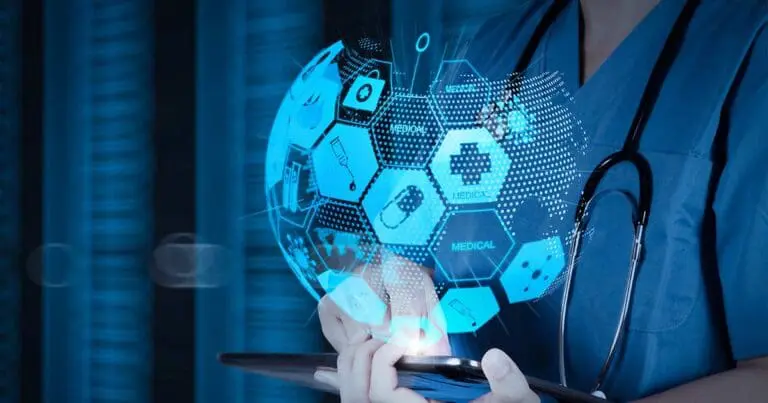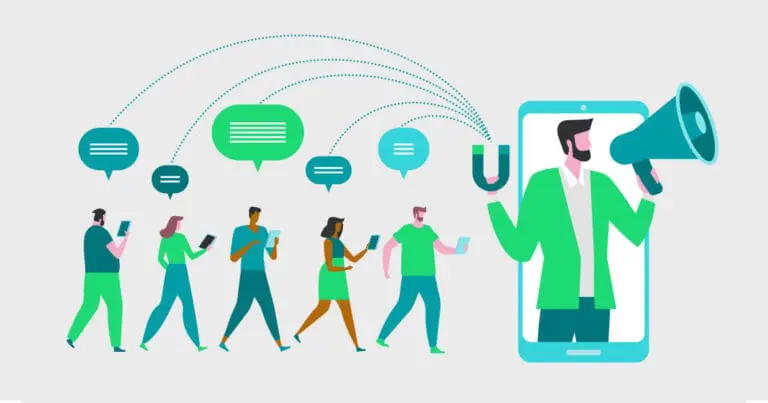5 Ways the Internet of Things (IoT) is Revolutionizing Healthcare

The Internet of Things (IoT) is a network of interconnected devices that communicate and share data seamlessly.
In the healthcare industry, IoT’s role is expanding rapidly, improving patient care, enhancing efficiency, and providing valuable insights for healthcare professionals.
This article explores five ways IoT is revolutionizing healthcare and the challenges organizations face while adopting this technology.
5 key areas where IoT is transforming healthcare
Key areas where IoT is transforming healthcare include remote patient monitoring, enhanced clinical workflow management, and predictive maintenance of medical equipment.
- Remote patient monitoring
- Smart wearable devices
- Enhanced clinical workflow management
- Medication management
- Predictive maintenance of medical equipment
1. Remote patient monitoring
Remote patient monitoring enables continuous tracking of patients’ vital signs, like blood pressure and glucose levels, providing timely alerts and interventions.
For instance, diabetic patients can monitor their glucose levels using a connected device that communicates data to healthcare provider systems, helping them adjust personalized treatment plans.
2. Smart wearable devices
Smart wearable devices like fitness trackers and heart rate monitors provide accurate and real-time health data on a person’s personal health metrics.
These devices help identify early signs of health issues, ensuring proactive intervention and encouraging patient compliance in managing their conditions.
3. Enhanced clinical workflow management
IoT streamlines clinical workflows by optimizing healthcare operations like inventory and patient management.
For example, IoT devices in hospitals can track bed availability, improve staff allocation, and automate medical facilities supply chains, reducing workload for medical staffs and ensuring efficient healthcare delivery.
4. Medication management
Smart pill dispensers and reminders ensure medication adherence by alerting patients to take their medication on time.
The adherence data collected through these IoT-enabled devices provides actionable insights for medical professionals to adjust treatment plans and minimize complications.
5. Predictive maintenance of medical equipment
By providing real-time monitoring of medical equipment health data, IoT enables predictive maintenance of essential tools like MRI machines and dialysis units.
This proactive maintenance reduces equipment downtime and prevents delays in medical treatment.
Understanding the role of IoT in healthcare
Understanding the role of IoT in healthcare means understanding the IoT devices used in healthcare, how IoT connects these medical devices, and the healthcare challenges IoT aims to address.
IoT devices used in healthcare
Key IoT-enabled devices include wearable sensors, smart pill dispensers, and remote patient monitoring systems.
These medical devices collect real-time data on patients’ vital signs, medication adherence, and activity levels, providing a deeper understanding of their health status.
How IoT connects medical devices
IoT technology connects medical devices through sensors, software, and data-sharing protocols, enabling seamless communication across various systems.
This interconnection allows real-time monitoring of patient conditions, providing healthcare professionals with comprehensive medical history and actionable insights for personalized treatment plans.
Healthcare challenges IoT aims to address
Traditional challenges in healthcare include high healthcare costs, hospital readmissions, and limited access to healthcare services.
IoT aims to address these issues by improving patient health outcomes, reducing hospital readmissions, and enabling proactive intervention for chronic illnesses through remote monitoring.
How IoT is transforming healthcare
IoT is transforming healthcare through improved patient outcomes, reduced hospital visits, and enhanced efficiency.
Improved patient outcomes
Real-time data monitoring and alerts ensure timely interventions, leading to improved health outcomes for patients with chronic illnesses.
Precision medicine and personalized care plans become easier to implement, allowing healthcare providers to tailor treatments that are specific to the patient’s unique health profile and needs.
Reduced hospital visits
Remote monitoring and proactive management of chronic diseases reduce unnecessary hospital visits, easing the burden on healthcare facilities and improving patient peace of mind.
This advance in medical care delivery enhances the efficiency of healthcare services while ensuring patients remain comfortable in their own homes.
Enhanced efficiency
IoT optimizes healthcare services and workflows, significantly increasing efficiency and reducing healthcare costs by delivering tangible cost savings in inventory management, staffing, and clinical operations.
These enhancements allow healthcare facilities to allocate resources more effectively, ensuring better patient care and operational excellence.
Challenges and considerations of IoT in healthcare
Challenges and considerations of IoT in healthcare include patient data privacy, medical device integration challenges, regulatory implementation issues, and the need for standardized adaptability standards.
Patient data privacy
With the integration of IoT in healthcare, protecting patient privacy and securing personal health information becomes paramount, as breaches can have serious ramifications.
Consequently, healthcare providers and tech companies must rigorously adhere to regulations set by regulatory bodies such as HIPAA in the United States and GDPR in Europe, implementing robust encryption and access control measures to safeguard patient data.
Medical device integration challenges
Integrating devices in healthcare can pose significant challenges due to the wide variety of protocols and standards employed across different devices.
To overcome these obstacles, device manufacturers and healthcare providers must engage in closer collaboration, ensuring their systems and devices can communicate effectively for seamless data exchange.
Regulatory implementation issues
Implementing IoT in healthcare necessitates a thorough understanding and adherence to complex regulatory frameworks that guarantee patient safety, data privacy, and the integrity of devices.
It is critical for healthcare providers and technology developers to collaborate closely, ensuring that IoT solutions comply with stringent standards such as FDA regulations for medical devices, to foster a secure and effective healthcare ecosystem.
The need for standardized adaptability standards
Standardized adaptability standards are necessary to achieve interoperability across various devices and platforms, ensuring consistency in data collection and analysis.
This uniformity is essential for healthcare providers to accurately monitor and respond to patient health data, regardless of the specific technologies in use.
Future trends and developments in IoT healthcare
Future trends and developments in IoT healthcare could include AI-enhanced IoT data analysis, telehealth integration, and comprehensive wearable medical tech.
AI-enhanced IoT data analysis
Artificial intelligence (AI) is set to revolutionize IoT data analysis by providing deeper insights into health trends and patient outcomes, enabling even more personalized medicine.
This advancement will facilitate proactive interventions for chronic diseases, significantly improving the quality of care and patient lifestyles.
Telehealth integration
Telehealth, integrated with IoT devices, will provide patients with seamless medical advice and monitoring from the comfort of their homes.
This fusion of technologies enhances accessibility to healthcare services, ensuring continuous care and support without the need for physical hospital visits.
Comprehensive wearable medical tech
Wearable medical technology will evolve to offer advanced environmental monitoring capabilities, detecting factors that may influence population health, such as air quality and UV exposure.
Furthermore, these devices will leverage predictive analytics to anticipate health trends and potential outbreaks, significantly enhancing preventive care strategies.
The IoT healthcare revolution
IoT has the transformative potential to revolutionize healthcare delivery, offering unprecedented levels of precision, personalization, and efficiency in patient care.
Healthcare organizations must adopt IoT-enabled devices responsibly, striking a balance between pioneering innovation and ensuring data security, privacy, and regulatory compliance.
Continued investment and focus on IoT research and development are critical for unlocking further advances in this field.
Such progress promises a future of healthcare characterized by better outcomes for patients, improved operational efficiency for providers, and innovative care solutions that were once thought impossible.
Looking to hire top-tier Tech, Digital Marketing, or Creative Talent? We can help.
Every year, Mondo helps to fill over 2,000 open positions nationwide.
More Reading…
- Cloud Data Security: Best Practices & Roles to Hire
- What is API Integration & Why Does Your Business Need It?
- Emerging Roles in Tech: The Need for AI Ethics and Its Impact
- How Technology is Shaping the Future of Public Transportation
- Benefits of Serverless Computing For Startups
- How to Adapt AI Customer Support Strategies in the Era of Chatbots
- Top AI Resume Builders to Get a Job in 2024
- Effective Workday Implementation & Key Roles to Hire
- Choosing the Right UX Designer to Hire for Your Team
- AI Overwhelm & 3 Things You Can Do Now to Get Started
- Leveraging AI for System Integration & the Demand for AI Talent
- AI You Didn’t Realize Your Organization Is Already Using
- Quantifying a Project Manager’s Success to Advocate for Hiring
- Highest Paid Data Science Roles & Top Salaries



